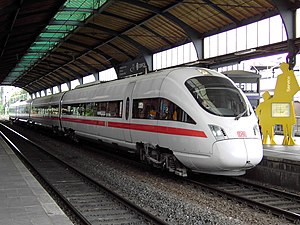ICE TD
| DBAG Class 605 | |
|---|---|
 |
|
| In service | 2001–present |
| Manufacturer | Bombardier/Siemens |
| Family name | Venturio |
| Number built | 20 trainsets |
| Number in service | 1 trainset |
| Formation | 4 cars per trainset |
| Capacity | 154 standard class, 41 first class |
| Operator(s) |
DB Fernverkehr DSB |
| Specifications | |
| Car body construction | Steel |
| Articulated sections | Flexible diaphragm (within unit only) |
| Maximum speed | 125 mph (200 km/h) |
| Weight | 232 t (228 long tons; 256 short tons) |
| Traction system | DEMU |
| Prime mover(s) | Cummins QSK19 (four engines) |
| Power output | 4 × 560 kilowatts (750 hp) = 3,000 hp (2,200 kW) at 1,800 rpm |
| Transmission | Diesel-electric transmission |
| UIC classification | 2′Bo′+Bo′2′+2′Bo′+Bo′2′ |
| Braking system(s) | Rheostatic |
| Safety system(s) | Sifa, PZB90, LZB, Eurobalise |
| Coupling system | Dellner |
| Track gauge | 1,435 mm (4 ft 8 1⁄2 in) standard gauge |
The DBAG Class 605, commonly known as the ICE TD is a high-speed diesel multiple unit (DMU) train, in service with Deutsche Bahn and DSB.
Following the successful inauguration of the Intercity-Express system in 1991 and the order to develop the ICE 2, in 1994 DB started plans to upgrade long-distance services using conventional lines, with comfort level raised near the ICE standard and higher speeds, with tilting electric multiple units to replace locomotive-pulled InterCity (IC) and InterRegio (IR) trains. DB assigned the name IC T to the project, with "T" standing for Triebzug (multiple unit). This development resulted in the ICE T.
Later, Deutsche Bahn also saw the need for a similar new train on its non-electrified routes, and started the ICT-VT project, with "VT" standing for Verbrennungstriebwagen (internal combustion motor car).
Deutsche Bahn pursued the development of the ICE 3, IC T and ICT-VT projects in parallel. The trains share a general styling concept, most prominently a lounge section in the front cars with a view forward at the tracks, being separated only by a glass wall from the driver's compartment. Technically, the trains share a lot of components and technical layout, as well as the concept of distributed traction: in contrast to the ICE 1 and ICE 2 designs, the new units were planned not with powerheads, but with peripheral underfloor motors, in order to reduce axle load (quite important for tilting trains) and increase tractive effort.
For the ICT-VT, a four-car configuration was chosen, without a restaurant car, otherwise, Deutsche Bahn aimed for a common appearance and the greatest possible technical commonality with the IC T. Even the possibility of coupling together an electric and diesel train and operate them jointly was to be provided.
In 1996, Deutsche Bahn placed an order for 20 diesel multiple units with a consortium led by Siemens.
As for the ICE T, DWA (Bombardier) produced the end cars and Siemens produced the middle cars. The ICE TD was fitted with an electro-mechanic tilting actuator system developed by Siemens, rather than the Fiat (Alstom) Pendolino hydraulic system used in the ICE T. Also, the secondary suspension between bogie and carbody is air springs rather than metal coils for higher ride comfort. A characteristic element of the Siemens system visible on the outside is the crescent-shaped top of the outer carbody supports (above the bogie center).
...
Wikipedia
